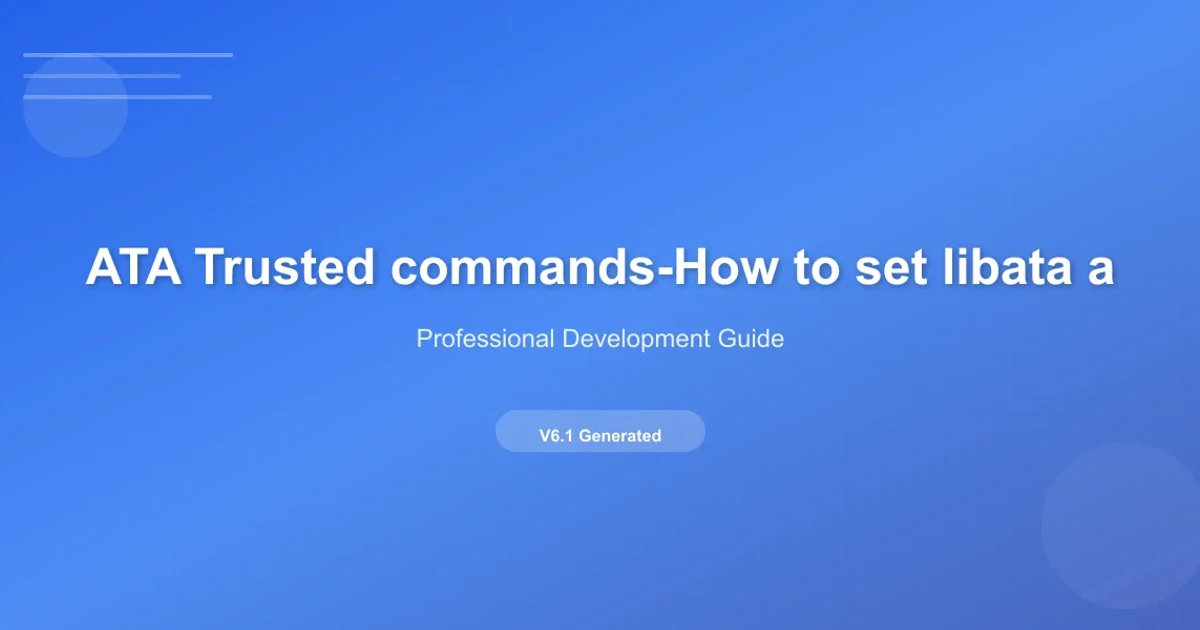ATA Trusted commands-How to set libata allow_tpm
Categories:
Enabling ATA Trusted Commands: How to Set libata.allow_tpm in Linux

Learn how to configure the libata.allow_tpm kernel parameter to enable ATA Trusted Commands, enhancing disk security and management on Linux systems.
ATA Trusted Commands are a set of security features built into modern hard drives and Solid State Drives (SSDs) that allow for hardware-level encryption management and secure erase functionalities. These commands are crucial for implementing robust data protection strategies, especially in environments requiring high security or compliance. On Linux systems, the kernel's libata subsystem manages ATA devices. To enable the use of these trusted commands, a specific kernel parameter, libata.allow_tpm, often needs to be configured. This article will guide you through understanding, enabling, and verifying the libata.allow_tpm setting.
Understanding ATA Trusted Commands and libata.allow_tpm
ATA Trusted Commands leverage the Trusted Platform Module (TPM) or similar hardware security features present in many modern storage devices. These commands allow for operations like:
- Hardware Encryption Management: Controlling the drive's built-in encryption engine, including setting and managing encryption keys.
- Secure Erase: Performing a hardware-level erase that securely wipes all data from the drive, making it unrecoverable.
- Access Control: Implementing granular access controls to the drive's security features.
The libata.allow_tpm kernel parameter acts as a gatekeeper. By default, many Linux distributions disable this feature for security reasons or to avoid potential compatibility issues with older hardware. Setting libata.allow_tpm=1 explicitly tells the libata driver to expose these trusted command interfaces to user-space applications, allowing tools like hdparm or specialized security software to interact with the drive's security features.
flowchart TD
A[Linux Kernel Boot] --> B{libata.allow_tpm set?}
B -- No (Default) --> C[ATA Trusted Commands Disabled]
B -- Yes (libata.allow_tpm=1) --> D[ATA Trusted Commands Enabled]
D --> E[User-space tools (e.g., hdparm) can access security features]
C --> F[Limited drive security management]
E --> G[Enhanced drive security management (e.g., hardware encryption, secure erase)]Flowchart illustrating the impact of libata.allow_tpm on ATA Trusted Commands.
Enabling libata.allow_tpm
Enabling libata.allow_tpm typically involves modifying your kernel boot parameters. This can be done temporarily for testing or permanently for persistent configuration. The most common method is to edit the GRUB bootloader configuration.
1. Edit GRUB Configuration
Open the GRUB configuration file, usually /etc/default/grub, with a text editor. You'll need root privileges for this.
2. Add Kernel Parameter
Locate the line starting with GRUB_CMDLINE_LINUX_DEFAULT. Add libata.allow_tpm=1 to the existing parameters within the double quotes. For example, if the line was GRUB_CMDLINE_LINUX_DEFAULT="quiet splash", it would become GRUB_CMDLINE_LINUX_DEFAULT="quiet splash libata.allow_tpm=1".
3. Update GRUB
After saving the changes to /etc/default/grub, you must update the GRUB bootloader configuration. The command for this varies slightly depending on your distribution.
4. Reboot System
Reboot your system for the changes to take effect. The kernel will now boot with libata.allow_tpm enabled.
# Example for Debian/Ubuntu
sudo nano /etc/default/grub
# Add libata.allow_tpm=1 to GRUB_CMDLINE_LINUX_DEFAULT
# Example: GRUB_CMDLINE_LINUX_DEFAULT="quiet splash libata.allow_tpm=1"
sudo update-grub
sudo reboot
Steps to enable libata.allow_tpm on Debian/Ubuntu systems.
# Example for Fedora/CentOS/RHEL
sudo nano /etc/default/grub
# Add libata.allow_tpm=1 to GRUB_CMDLINE_LINUX
# Example: GRUB_CMDLINE_LINUX="rd.lvm.lv=fedora/root rd.lvm.lv=fedora/swap rhgb quiet libata.allow_tpm=1"
sudo grub2-mkconfig -o /boot/grub2/grub.cfg
sudo reboot
Steps to enable libata.allow_tpm on Fedora/CentOS/RHEL systems.
Verifying the Setting and Using Trusted Commands
After rebooting, you can verify that the libata.allow_tpm parameter has been successfully applied and that your drives support trusted commands.
cat /proc/cmdline
Verify kernel boot parameters.
Look for libata.allow_tpm=1 in the output. If it's present, the kernel has loaded with the parameter enabled. Next, you can check if your drive supports and exposes trusted commands using hdparm.
sudo hdparm -I /dev/sda | grep -i "Trusted"
Check for ATA Trusted Command support on /dev/sda.
If your drive supports trusted commands and libata.allow_tpm is enabled, you should see output indicating support for features like 'Trusted Computing' or 'Trusted Send/Receive'. You can then use hdparm or other specialized tools to manage these features, such as performing a secure erase or configuring hardware encryption.
hdparm commands for managing trusted features can be complex and vary by drive model. Always consult your drive's documentation and the hdparm man page for specific usage.